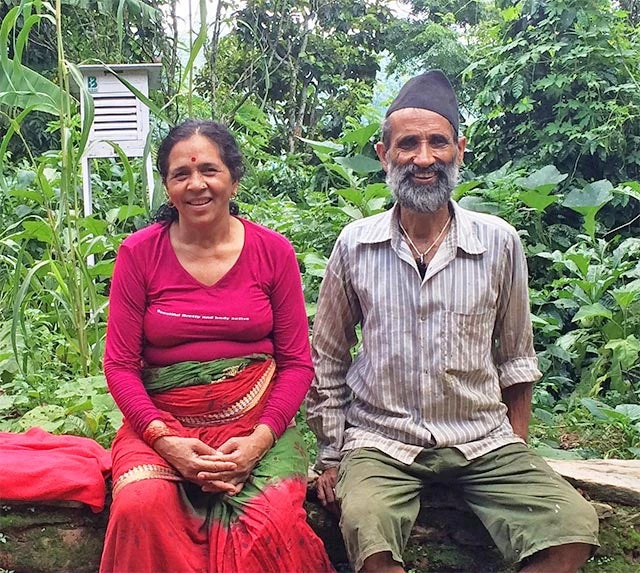
Photo credit: Bioversity International/J. Zucker
I recently visited one of Bioversity International’s project sites in Begnas, where I met farming couple, Surya and Saraswati Adhikari. They proudly showed me around their biodiverse farm, pointing out some of the 150 plant species they grow and explaining that each one has a specific use. They showed me the vegetables, rice, gourds and legumes they grow to eat and sell; the trees that provide fruits, fodder and fuel, and the many herbs for medicinal and cultural purposes.
This land was not always so fertile. The terrain was difficult to cultivate and waterlogged. Hard work, and a mix of traditional and scientific knowledge about how to use agricultural biodiversity for sustainable production, has slowly turned the land into a profitable and productive enterprise.
What impressed me was their detailed knowledge of the different species and varieties they grow, and how to use this agricultural biodiversity to promote a healthy and productive food system. For example, planting shrubs like the Malabar nut, whose leaves can be used as green manure to fertilize the land, and fruit trees, such as Cinnamomum, that are known to attract birds. Birds, in turn, disperse wild tree seeds, helping to make the farm more biodiverse and resilient.
Of course a food system goes beyond the boundaries of a single farm. Surya and Saraswati are also part of a larger ‘Community-based Biodiversity Management’ approach in the Begnas valley. This has put the governance of land and biodiversity into the hands of the people who depend on it.
The communities, working with the support of the Lekhnath Municipality, have brought together different stakeholders, including cooperatives, development committees and women’s groups, to adopt sustainable practices that reverse soil erosion and increase productivity.
Activities include collective reforestation, diversification, apiculture, agroforestry and organic crop production. Lake restoration and land use diversification have supported the conservation of crop genetic diversity including landraces and crop wild relatives, whose habitats are now protected.
This kind of ‘Community-based Biodiversity Management’ approach recognizes the intrinsic link between agricultural biodiversity, people, food and the environment. It empowers communities to restore and sustainably manage their own landscapes to meet their needs.
Over the last 10 to 15 years, this governance approach has been tested, demonstrated and further refined or adapted in Nepal, and around the world, through the implementation of a global on-farm conservation project, led by Bioversity International.
Fifteen districts are now also adopting this approach as the programme is scaled out in Nepal and elsewhere in India and Indonesia. The good news is that similar examples of communities managing their own land and agricultural biodiversity resources for sustainable development can be found around the world. Success requires support at the local government level, a common vision and a strong network of stakeholders that are guided by an overarching organization that provides strategic and technical guidance.
This year's International Day for Biological Diversity theme is ‘Mainstreaming Biodiversity; Sustaining People and their Livelihoods’. Land degradation, population growth and climate change are just some of the challenges affecting farmers like Surya and Saraswati Adhikari around the world. Agricultural biodiversity is one of the primary tools in the resource box that farmers can use to overcome these challenges.
But biodiversity is at risk. Kew Garden’s recently published State of the World’s Plants estimates there are 5,500 plant species known to be used for human food. Kew’s report also estimates that one in five plants globally are threatened with extinction . Ironically, agriculture itself is responsible for some of this threat, due to food production and consumption patterns that focus on a relatively narrow range of crops and animals.
Incorporating agricultural biodiversity into productive and resilient farms that provide nutritious diets and generate income, can generate benefits for today’s farmers, consumers and the environment alike, while safeguarding this precious resource for future generations. Bioversity International’s work in Nepal has only been made possible through the critical support of our many implementation partners, in particular ‘Local Initiatives for Biodiversity, Research and Development’ (LI-BIRD).
Bioversity International is a member of the CGIAR Consortium - a global partnership for a food-secure future. The World Bank are contributors to, and administrators of, the CGIAR Fund.
Tweet these:
Empowering farming communities 2 manage #biodiversity in #Nepal #IDB2016 @anntutwiler
Celebrating #IDB2016 through community #biodiversity management in #Nepal
#agrobiodiversity helping to make farms more resilient and productive in #Nepal #IDB2016


Join the Conversation